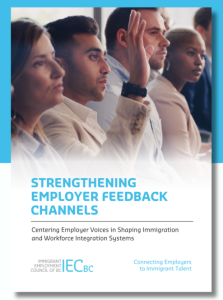|
Getting your Trinity Audio player ready...
|
Across Canada, employers are balancing persistent labour shortages with fast-changing skill demands. Through the Strengthening Employer Feedback Channels (SEFC) initiative, the Immigrant Employment Council of BC (IEC-BC) and partners across the Immigrant Employment Councils of Canada (IECC) National Network convened employers and ecosystem stakeholders to turn feedback into concrete changes in hiring and retention.

In our engagement, most employer participants had already hired newcomers, yet nearly half still reported challenges in recruiting or retaining them. That tells us the willingness is there, but the friction is real.
This context matters even more because small and medium-sized enterprises make up almost all employer businesses in Canada and carry most private-sector jobs, yet they often struggle most in recruiting and retaining immigrant talent. National data show SMEs account for 98% of employer businesses and employ about 64% of the private-sector workforce, according to Statistics Canada.
Where we started
We began SEFC with a basic question: if employers want to hire newcomers, and many do, why does it still feel hard on both sides? We did not want another survey that disappears into a report. We set up real conversations that could name what is getting in the way, in plain language.
Who we talked to
Over 18 months, we sat down with employers of all sizes across Canada: manufacturing shops and tech firms, hospitals and hotels, city offices and farms. We also brought in community partners, educators and local government so everyone could hear the same things at the same time. More than half the voices in the room were employers, which kept the discussion grounded in day-to-day reality.
Read more on “Supporting Newcomer Success” in our article series:
- How career services can support international students amid a shifting immigration landscape
- Canada needs a bridging culture to support newcomer success
- Resources to help employers hire – and keep – newcomer talent
What we heard (in employers’ words)
“We are busy and short on HR.” In many small and mid-sized companies, the owner is also HR, the recruiter and the trainer. When a resume lands, they have minutes, not hours. If a profile is hard to read, it gets set aside, not because the person is not qualified but because the day is already full.
“International credentials do not come with a translation guide.” Employers are not doubting international education or experience. They lack fast, trusted ways, and the time, to interpret them against local standards. Without that translation, it is hard to be confident about fit.
“Our job ads have not kept up.” Many postings are hand-me-downs, long wishlists that do not match how the work is done today. Under pressure, there is little time to rewrite them, and that creates mismatched expectations later.
“Onboarding matters, but bandwidth is tight.” Leaders know the first weeks make or break a hire. The supervisors who would coach a newcomer are also juggling safety briefings, production goals, client needs and new systems. Good intentions lose to the urgency of the day.
“Finding the right door is confusing.” There are many immigration programs and services, but names, rules and contacts change. Employers spend too much time figuring out who to call, and often start over when staff move on.
“Employers value internationally trained talent, but they operate with limited time, limited translation tools and constant change.”
“Rules change faster than our operations.” Immigration pathways, funding and training options shift quickly. Skills needs shift too. Keeping up with all of it while running a business is tough, especially without a dedicated HR team.
“Culture is more than language.” Employers talked about how work works here: how decisions are made, how feedback is given, what “done” looks like, how teams stay safe. When those cues are not shared, small misunderstandings can snowball even when technical skills are strong.
“Life outside work affects staying power.” Housing costs, commute times and shift schedules often decide whether someone can accept, or keep, a job. This is especially true outside big transit corridors and for early or late shifts.
“With thin teams, we choose the safer option.” When time is tight and signals are unclear, employers fall back on what feels familiar, such as local experience, known schools and narrower shortlists. It is not reluctance to hire newcomers; it is risk management when there is no room for error.
Bottom line: Employers value internationally trained talent, but they operate with limited time, limited translation tools and constant change. In that setting, the safer and slower choice becomes the default.
So, given what employers told us, how can newcomers reduce friction and boost their chances of being considered for openings that fit their skillset and career experience?

Five practical tips for newcomers (and the counsellors/coaches who support them)
- Lead with proof, not promises. Build a proof-of-skill kit: a one-page results sheet with numbers and outcomes, one or two work samples or short case write-ups, and a tools-and-methods list that mirrors the job ad. Link it on your resume and bring it to interviews.
- Translate your background, fast. Create a credential translation card in plain Canadian terms. Explain what your degree or licence equals here, the types of roles it maps to and any recognition steps with timelines. This is not defending your past – it is saving employers time.
- Show your ramp plan. Draft a 30-60-90 day outline for one target role that you could share with the hiring manager during the recruitment process when appropriate, or during your onboarding. Note what you will deliver, what you will learn and how you will check in. Say, “Here is how I plan to ramp.” You reduce the manager’s day-one risk.
- Aim for niche, not volume. Pick a small set of roles and sectors where your tools and problems match. Use warm paths, such as sector associations, councils, chambers, alumni and meetups, to meet hiring managers. Ten tailored applications beat 50 generic ones.
- Consider company culture and keep moving. In interviews ask, “How is feedback given?” and “What does success look like at 30 and 90 days?” Confirm commute and shift fit and mention any ready solutions. Keep a learning plan with two high-leverage skills per quarter and treat any survival job as a bridge with milestones and an exit date.
Five reflective questions for employers (to access and retain internationally trained talent)
- Where do candidates drop off, and why? Look at each step: posting, screen, assessment, interview, offer. Which signals or tools might be filtering out qualified international profiles?
- What is truly must-have at hire versus trainable in 60 to 90 days? If it is trainable, do posting, screening and onboarding reflect that, or are you still hiring as if everything is a day-one essential?
- What evidence counts beyond local experience? Define acceptable proof such as work samples, task simulations, structured references, supervised trials and micro-credentials, and make sure teams use it consistently.
- How ready are managers for weeks 1 to 4? Do teams have a light 30-60-90 plan, a buddy model and a feedback cadence? How do you know if time-to-productivity and first-quarter retention are improving?
- Which real-world frictions matter most here, and who are our partners? For each role and location, which practical factors – such as commute, shift timing or licensing steps – matter most? Which local partners can help reduce those barriers?
Use these questions in your next hiring huddle or leadership meeting. Pick one area to improve, test it on the next vacancy and learn forward.
Closing the loop
Better use of internationally trained talent does not hinge on a single program or player. It depends on strategic partnerships and shared investment.
Employers, career and settlement services, training providers, sector councils and governments each hold part of the solution. If your organization is feeling the squeeze of a changing skills market, choose one partnership to deepen, measure what changes and build from there.
Finally, remember that this is the work of a network, not a solo act. The more we pool signals and resources, the faster we turn potential into performance.
Read the full report on the project, methodology and findings.




